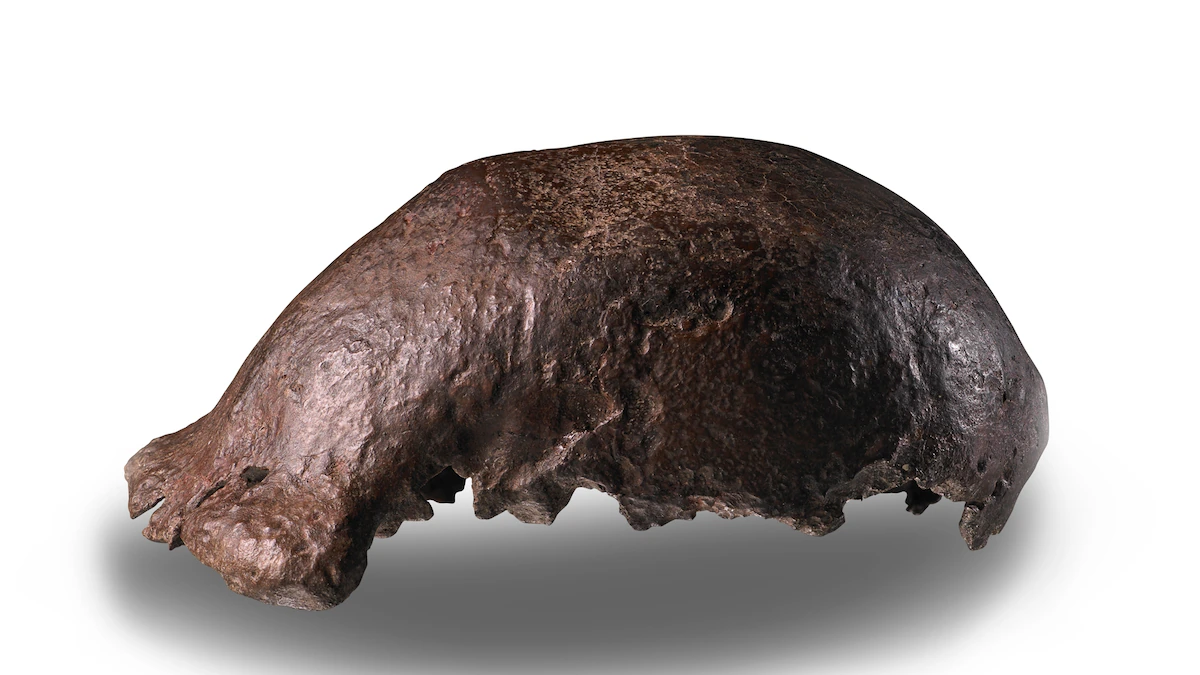Copyright National Geographic

In 1866 Raden Saleh, a Javanese nobleman and naturalist painter, traveled to the eastern part of Java to see the so-called “battlefield of the giants.” Local farmers there had found massive bones, which they said belonged to the giant demon king Arimba, a figure from the Javanese version of the Sanskrit epic, Mahabharata. Intrigued, Saleh visited “the battlefield” and identified the large bones as fossils belonging to animals from the ancient past. Decades later, Saleh’s fossil report reached Eugène Dubois, a Dutch physician and naturalist who was on the quest of finding “the missing link” in human evolution. He believed it must be hidden in the tropical Southeast Asian islands, home to various ape species like orangutans and gibbons (most of it was a Dutch colony and became Indonesia in 1945). He had searched Sumatra to no avail. But convinced by the abundance of fossils that Saleh found, Dubois set his eyes on East Java. There in Trinil in 1891, he found what he believed he was looking for. Dubois—using Javanese forced laborers—excavated a skullcap, molar, and thigh bone belonging to an ancient hominin. Compared to Neanderthals, which had been formally named a new species in 1864, this new specimen had a smaller brain volume that was closer to an ape’s, and its thigh bone indicated it could walk upright. In a 1894 paper, Dubois presented the fossils as “Pithecanthropus erectus” or “the ape-man that walks upright.” Later in the 1950s, scientists classified it as the first-ever evidence of Homo erectus. The discovery of the so-called “Java Man” shocked the scientific community as it was seen as evidence to further support Charles Darwin's theory of evolution. LIMITED TIME OFFER “It was the first proof that human origin is no exception in Darwinian evolution,” says Soefwan Noerwidi, a paleoanthropologist at Indonesia’s National Agency for Research and Innovation (BRIN). “The field of human evolution was born here in Java.” Yet, despite Indonesia's contributions to our understanding of human origins, its most prized fossil has not been home for 130 years. Dubois brought the skull back to the Netherlands in 1895. Several diplomatic efforts failed to bring it back to Java. Until now, after more than a century of residing in Naturalis Biodiversity Center in Leiden, the “Java Man,” is set to fly back home to Indonesia. The famous fossil, along with 28,000 other fossils Dubois collected “in the battlefields,” will be returned to Indonesian museums, the Naturalis announced on September 26 after the culture ministers from both countries signed the long-awaited agreement. (Are museums celebrating cultural heritage—or clinging to stolen treasure?) The "Java Man’s" return to Indonesia is a part of ongoing pressure on North American and European museums to repatriate ethically problematic natural history objects back to their origins. In 2016, the United States repatriated looted dinosaur fossils back to Mongolia and Germany had sent back 110-million-year-old dinosaur bones to Brazil. For Indonesian scientists, such restitutions mean more than correcting colonial injustice in the past. The closer proximity to their research objects is also a liberation, a wider opportunity to participate in global paleontology research, says Noerwidi. “The absence of Dubois collections has been a great loss for Indonesian science,” says Anton Wibisono, the subdirector of Cultural Advocacy at Indonesia’s Ministry of Culture. Wibisono, who was a student in archaeology, says that he’s excited to finally see in-person the famed fossils from his homeland that he learned about in textbooks and lectures. “I’m deeply moved hearing the news." Efforts to return 'Java Man' The repatriation of the "Java Man" is long overdue, says Caroline Drieenhuizen, a historian in Open Universiteit in Heerlen. The Netherlands have approved several repatriation requests of cultural objects and human remains already, but the “Java Man” agreement is the first restitution of natural history collections in the country, she says. This matters because “natural history museums had long escaped decolonial scrutiny, while their museum collections are also rooted in colonial practice and thinking,” Drieenhuizen wrote in a 2021 paper. In its report explaining the decision, the Netherland’s Colonial Collection Committee pointed out that Dubois’ fossils were excavated at the time of “violence, exploitation, and power imbalance.” The diplomatic efforts to bring home the fossil started in the 1950s when Indonesia started constructing a national narrative that unites people from hundreds of different languages and thousands of islands. “The 'Java Man' fossils then served as the scientific proof for Indonesia’s greatness and importance to the world,” says Fenneke Sysling, a historian of science in Leiden University. But the 1950s proposal and another one in the 1970s were not successful. Starting in 2016, the call for restitutions of problematic objects in Netherlands museums became a public discussion. So far, the country has approved a number of repatriations of cultural objects and human remains to various countries, such as 119 Benin Bronzes to Nigeria in 2025, 233 pre-Hispanic artifacts to Mexico in 2022, and 1,500 cultural artifacts to Indonesia in 2022. Amid these restitution movements, the Indonesian government submitted another repatriation proposal to the Netherlands in 2022. It was resisted at first by Naturalis which argued that buried fossils are different from art treasures, but legal assessments finally convinced the Dutch government to let go of the "Java Man." “It’s the first-time legal issues dominate a repatriation argument,” says Drieenhuizen, highlighting the Dutch’s past reluctance to return the fossil. (Kenya wants its treasures back. Replicas could spur their return) “The pieces were part of our identity and highlight of our museum collection,” says Bart Braun, a spokesperson for the Naturalis Biodiversity Center. “But we realize this is a very important moment for Indonesians, as it corrects a past injustice.” He says the museum is currently registering and digitizing the 28,000 fossils. The ordeal could take “many months” before the actual repatriation happens. A new era in Indonesian science From the Indonesia side, Wibisono, the Indonesian ministry culture official, says his team will follow up on the technical side of the repatriation efforts at the end of the year. “We are more than ready to accept these specimens,” says Wibisono. One possible house for the fossils, he says, is the Sangiran Early Man Museum in Central Java. It already hosts thousands of ancient plants and animal specimens, including pieces of H.erectus fossils found after Dubois 1891 excavation. Gadjah Mada University in Yogyakarta and Noerwidi’s office in BRIN also store thousands of fossils including the legendary H. floresiensis, says Rusyad Adi Suriyanto, a paleoanthropologist at the university. (The story of Nigeria's stolen Benin Bronzes, and the London museum returning them) Dwirahmi Suryandari, a pre-doctoral fellow at the Max Planck Institute for the History of Science in Berlin, says Indonesia could use the waiting time to prepare how the specimens could be connected to global research environment. “Like any other museum collection, the ‘Java Man’ should not end up in the exhibit only, but we need to make him ‘alive’ by active research,” says Suryandari. Considered as the holotype—or the main reference—of H.erectus fossils, the "Java Man" plays a crucial role in paleoanthropology research. The fossil was quintessential to scientists’ early understanding of human evolution, and was even used as evidence in defense of the theory of evolution in the United States’s 1925 Scopes Monkey Trial. “The return of the fossils might change research access to the fossils, and also put such control back into Indonesian hand,” says Frido Welker, a paleoanthropologist at the University of Copenhagen who is now collaborating with Noerwidi in BRIN to analyze “the protein preserved in the skeletal material from Dubois collection.” (How ancient DNA—from Neanderthals to the Black Plague—has transformed archaeology) Now with the "Java Man" coming back to Indonesia and with advanced labs on ancient DNA, proteomics, and CT-scan technologies arising in Indonesia, Noerwidi says he’s excited. Much in the same way that the Javanese painter Raden Saleh added scientific meaning to the giant bones he found in “the battlegrounds,” today’s Indonesian scientists will now have an opportunity to add more meanings to the fossils found in their homeland, like the "Java Man." “The return of these fossils is just so liberating,” Noerwidi says.



